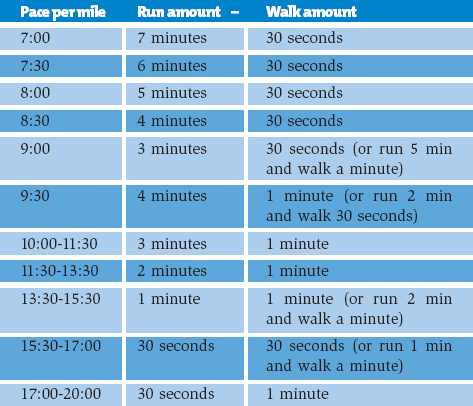
I doubt that you will find any training component that will help you in more ways than my run-walk-run™ method. I continue to be amazed, every week, at the reports of how these strategic walks help runners to enjoy the Half-Marathon as they improve their finish time. When placed appropriately for the individual, walk breaks will erase fatigue, reduce stress, improve motivation, increase running enjoyment, speed up recovery, and allow the runner to finish with strength. Here’s how it works.
Walk before you get tired
Most of us, even when untrained, can walk for several miles before fatigue sets in, because walking is an activity that we can do efficiently for hours. Running is more work, because you have to lift your body off the ground and then absorb the shock of the landing, over and over.
The continuous use of the running muscles will produce more fatigue, aches, and pains than running at the same pace while taking walk breaks. If you walk before your running muscles start to get tired, you allow the muscle to recover instantly—increasing your capacity for exercise while reducing the chance of next-day soreness.
The “method” part involves having a strategy. By using a ratio of running and walking you can manage your fatigue. Using this fatigue-reduction tool conserves resources and bestows mental confidence to cope with any challenges that can come later. Even when you don’t need the extra strength and resiliency bestowed by the method, you will feel better during and after your run, and finish knowing that you could have gone further.
“The run-walk method is very simple: you run for a short segment and then take a walk break, and keep repeating this pattern.”
Walk breaks allow you to take control over fatigue, in advance, so that you can enjoy every run. By taking them early and often you can feel strong, even after a run that is very long for you. Beginners will alternate very short run segments with short walks. Even elite runners find that walk breaks on long runs allow them to recover faster. There is no need to be totally exhausted at the end of any long run.
Walk breaks….
• |
Give you control over the way you feel at the end. |
• |
Erase fatigue. |
• |
Push back your fatigue wall. |
• |
Allow for endorphins to collect during each walk break—you feel good! |
• |
Break up the distance into manageable units. (“two more minutes”). |
• |
Speed recovery. |
• |
Reduce the chance of aches, pains and injury. |
• |
Allow you to feel good afterward—carrying on the rest of your day without debilitating fatigue. |
• |
Give you all of the endurance of the distance of each session—without the pain. |
• |
Allow older runners or heavier runners to recover fast, and feel as good or better as during the younger (slimmer) days. |
A short and gentle walking stride
It’s better to walk slowly, with a short stride. There has been some irritation of the shins, when runners or walkers maintain a stride that is too long. Relax and enjoy the walk.
No need to ever eliminate the walk breaks
Some beginners assume that they must work toward the day when they don’t have to take any walk breaks at all. This is up to the individual, but is not recommended. Remember that you decide what ratio of run-walk-run to use. There is no rule that requires you to hold to any ratio on a given day. As you adjust the run-walk to how you feel, you gain control over your fatigue.
I’ve run for about 50 years, and I enjoy running more than ever because of walk breaks. Each run I take energizes my day. I would not be able to run almost every day if I didn’t insert the walk breaks early and often. I start most runs taking a short walk break after a minute of running. By 2 miles I am usually walking every 3-4 minutes. By 5 miles the ratio often goes to every 7-10 minutes. But there are days every year when I stay at 3 minutes and even a few days at 1 min. On long runs, however, I set my ratio to be the most conservative I can imagine—and stay with it throughout.
How to keep track of the walk breaks
There are several watches which can be set to beep when it’s time to walk, and then beep again when it’s time to start up again. Check our website (www.jeffgalloway.com) or a good running store for advice in this area.

Run-Walk-Run ™ ratios
After having coached over 100,000 runners using walk breaks, I’ve come up with the following suggested ratios:

| Note: | You may always divide each of the amounts by 2.
Example: instead of running 7min/walking 30 seconds, you could run 3:30 and walk 15 seconds. This allows for you to walk through a water stop that is placed irregularly. |